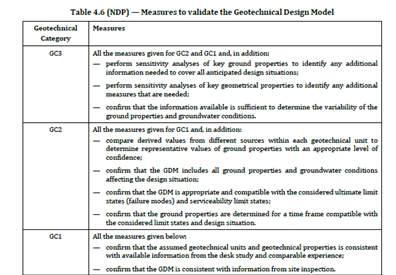Introduction
This note has been prepared based on a review of the draft prEN 1997 dated August 2022.
Geotechnical Unit
A geotechnical unit is defined in prEN 1997-1 as a ‘volume of ground that is defined as a single material’. Ground can be soil, fill or rock existing in place before any construction works, each with its own hydraulic conductivity.
A unit will have a description and classification based on designation of material parameters and identification of the data used in the selection of representation values of ground properties.
These units are normally identified prior to the start of the ground investigation as part of the initial desk study, site inspection and preliminary investigation (prEN 1997-2, 5.2.2 to 5.2.4). These are required as part of the planning of the design investigation (5.25) and develop as the project cycle evolves. The ground investigation should identify strength, stiffness, anisotropy and geometrical variation of the units.
Normal UK practice would give responsibility for these initial works either to the Specialist Ground Investigation Contractor, or sometimes to a Geotechnical Consultant appointed at an early stage in the Project.
Ground model
The concept of the Ground Model is familiar to all practitioners site specific outline of the disposition and character of the ground and groundwater based on the results of ground investigations and other available data. These conditions will have an influence on the site (and this may also need to include the recognition of potential ground conditions and sources outside the site boundary), on the design itself, and finally the construction of the project.
The draft prEN 1997-2, 4.1 states that a Ground Model shall comprise the geological, hydrogeological and geotechnical conditions of the site as determined by the ground investigation, and is one of the main outputs to be included in the Ground Investigation Report (GIR). The Ground Model also forms the basis for development of Geotechnical Design Model [GDM] for each geotechnical design situation and each geotechnical structure (prEN 1997-1, 4.2.3).
As an example, the Ground Model should consider, but not be limited to, the geomorphology of the site, geometrical and geotechnical properties of the geotechnical units, but also discontinuities and weathered zones. The Ground Model shall state the variability and level of uncertainly of the conditions and properties alongside derived values from relevant ground properties of all geotechnical units encountered.
Without the Ground Model, the GIR would not be able to identify the derived values of the geotechnical units.
As the Ground Model is one of the principal outputs from the initial desk study, site inspection, preliminary or design investigations and is to be included in the GIR, development of the Ground Model is usually the responsibility of the Specialist Ground Investigation Contractor, or is sometimes passed to a Geotechnical Consultant appointed at an early stage in the Project.
The draft prEN 1997-2 states the Ground Model shall be developed and updated as new potential information is made available. Without the ground model, a GDM cannot be developed and validated. Any changes to the ground model shall be documented in the Geotechnical Design Report (GDR). Updating the Ground Model at this stage may therefore fall to the Geotechnical Designer rather than the original Specialist Ground Investigation Contractor.
Geotechnical Design Model
The GDM is a conceptual representation of the site derived from the ground model for the verification of each appropriate design situation and limit state. It is based on the Ground Model which has verified against the variability and uncertainty of the ground conditions.
The GDM should include, but is not limited too
- tabulation or graphical cross sections of the geotechnical units
- representative values of ground properties for all the geotechnical units encountered in the zone of influence.
- inclusion of groundwater table
- and the process of compiling the GDM.
The GDM should also consider the
- variations of groundwater in all directions within each geotechnical unit. There may be occasions where groundwater pressures may be classified as accidental actions, as detailed in prEN 1997-1, 6.1.
- identification of any spatial trends
Normal practice in the UK is that the development of individual GDMs would be the responsibility of the Geotechnical Specialist appointed to design each geotechnical structure for the appropriate geotechnical design situation and then included in the GDR. On most projects, there may be multiple GDRs often prepared by different designers. Guidance on the content of the GDR is given in prEN 1997-3. The individual GDRs may be collated into a single Project GDR.
The reliability of the GDM must be validated using the guidance given in prEN 1997-1, Table 4.6 for the appropriately selected Geotechnical Category [GC]. The GC would have been selected as part of the GIR. Table 4.6 has been reproduced as follows:
The validation process should also review the quantity, quality and appropriateness of the information taken from the GIR. This is done to determine sufficient confidence in the GDM to ensure the level of reliability required by prEN 1990 is obtained, and additionally, that the measures taken to validate the GDM according to the GC are adequate. If neither condition is met, or there is insufficient confidence in the level of reliability then additional ground investigation shall be performed.
The GDM is reported in the GDR for each geotechnical design situation and for each geotechnical structure. Guidance on the content of the GDR is given in prEN 1997-3.
The AGS Geotechnical WG are preparing a number of other Bitesize Guides covering various Second-Generation EC7 topics, and if anyone has a burning desire to say something, get in touch with Katie, Alex Dent or Chris Raison via ags@ags.org.uk.
Guide produced by Emma Cronin, SOCOTEC.
